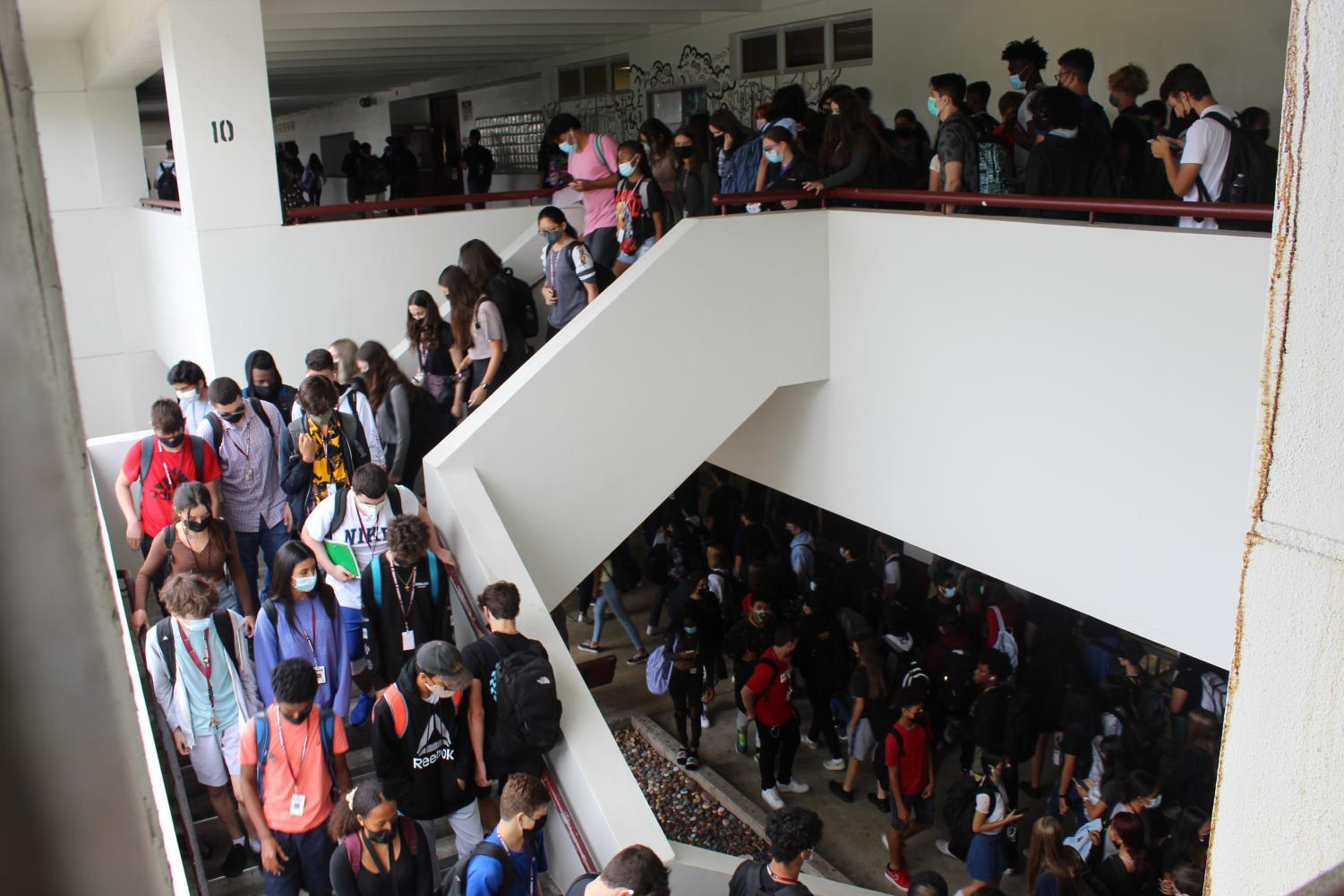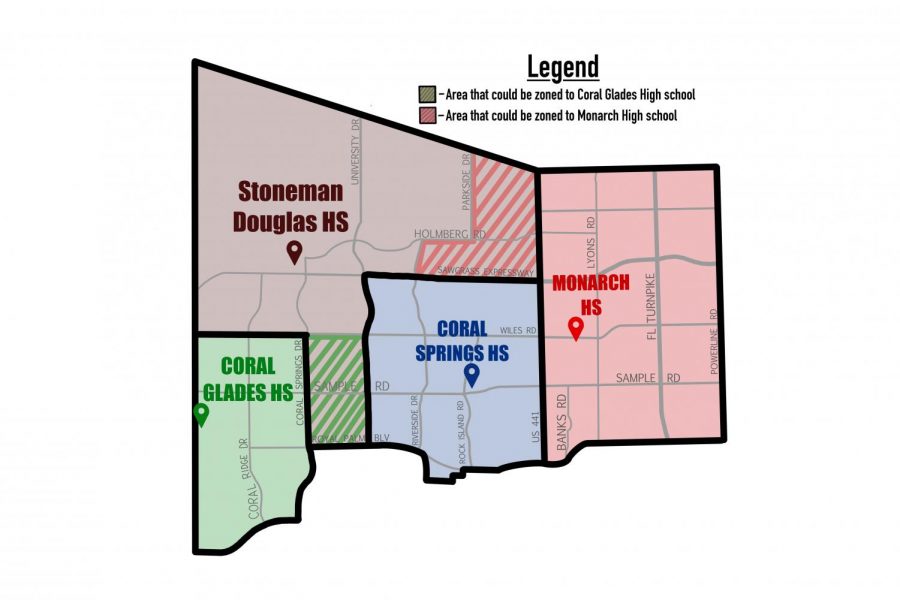Your donation will support the student journalists of Marjory Stoneman Douglas High School. Your contribution will allow us to purchase equipment and cover our annual website hosting costs.
Maxed Out
MSD enrollment causes overcrowding; state capacity report does not accurately reflect available instructional space, preventing solutions
October 20, 2021
With the 2021-2022 school year underway, students and staff at Marjory Stoneman Douglas High School are feeling the effects of increased enrollment. This increase has raised many questions: is MSD over-enrolled? How has this increase impacted classroom sizes? Will MSD need to hire more teachers to accommodate the influx of students? Are overcrowded classes posing a safety threat? What can be done to better accommodate the influx of students?
As a result of teachers and students reporting an increase in the typical number of students present in both core classes and elective classes, the Eagle Eye spent six weeks investigating the issues arising from increased enrollment. The investigation included digging into school enrollment numbers, capacity number calculations, Florida Administrative Code, boundary redistribution practices and state statute for class size. In the course of the investigation, the Eagle Eye discovered that the school’s official capacity numbers are inflated by the continued inclusion of the 1200 building in the reporting of the schools’ available instructional classroom space. This has the potential to exacerbate current overcrowding at MSD for years to come.
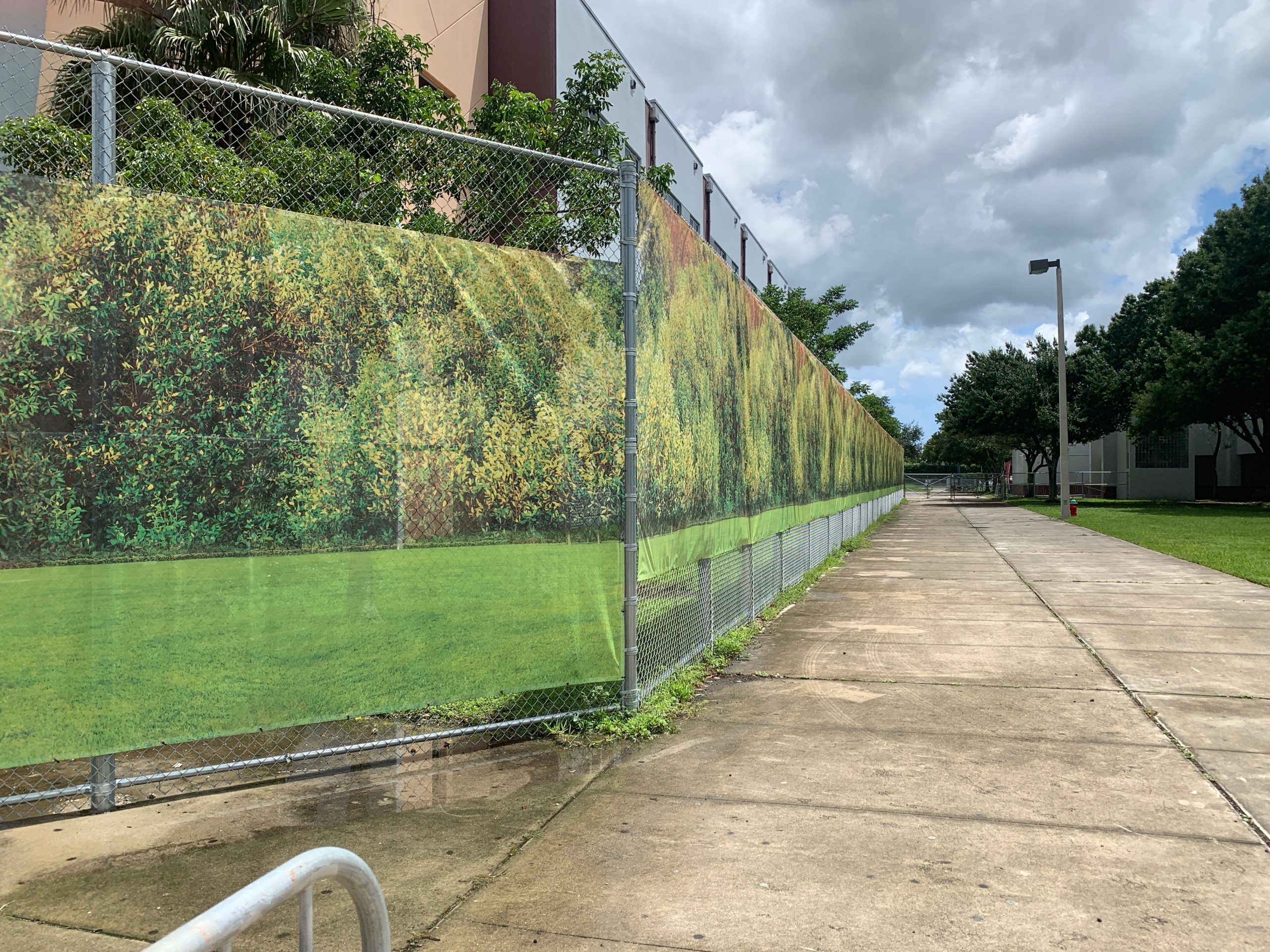
Zoe Gordon
Installed in August 2019, a new banner depicting a calming forest scene surrounds the 1200 building. Following the Feb. 14, 2018 shooting at Marjory Stoneman Douglas High School that killed 17 students and staff members and injured another 17, the building has been designated a crime scene and is in the custody of the state attorney’s office. The building is still being reported as usable classroom space on the Florida Inventory of School Houses report for MSD.
Carrying Capacity
The Florida Department of Education provides every school in Florida with a Florida Inventory of School Houses report measuring the occupancy for permanent and relocatable buildings on a school campus. This FISH report essentially provides the square footage of every classroom on campus to allow the school to set the number of students that should be placed per class per period. In addition, the report provides an overall number of students that the school can ultimately hold: the school capacity number.
At MSD, the FISH capacity number is currently calculated at 3,789 students. With school enrollment increasing over the past few years by 7.5%, the current school enrollment number for this year is 3,570. Comparatively, last year’s enrollment was 3,289, meaning there has been an increase of 281 students this school year, which can still fluctuate slightly during the year with new student enrollments or student withdrawals.
The official capacity number is affected by the continued inclusion of the 1200 building in MSD’s FISH report. This building accounts for 30 classrooms, which has the capacity to hold 713 students. The building has not been occupied since the Feb. 14, 2018 shooting at MSD, which resulted in the death of 14 students and 3 faculty members and physically injured 17 more. The building has been designated a crime scene until the conclusion of criminal proceedings against the shooter, and is under the jurisdiction of the State Attorney’s Office and the Broward Sheriff’s Office. In 2018 the Florida Legislature provided $20 million to Broward County Public Schools for the demolition of the 1200 building and the construction of a replacement building.
The 1500 building opened during the 2020-2021 school year with 30 additional classrooms, which added a capacity of 750 students to the school’s FISH report. The purpose of the addition was to replace the capacity lost from the inaccessibility and eventual demolition of the 1200 building. The intention was not to raise the FISH capacity, but to level out the capacity to the number before the incident. In fact, the Eagle Eye discovered a lack of communication between BCPS district officials and at least one MSD administrator, who was not aware that the 1200 building was still being calculated in the school’s total capacity by the district.
To date, the school’s FISH capacity number remains 3,789, which includes both buildings and raises the capacity of the school to an inaccurate number. To calculate the school’s actual capacity, 712 must be subtracted, which leaves room for 3,077 students. As previously stated, the current enrollment stands at 3,570 students.
One of the main problems this creates is that it makes MSD appear to be under-enrolled by 219 students on paper. In reality, since students and staff are only able to utilize the equivalent space for 3,077 students, MSD is over-enrolled by 493 students, which means the school is actually functioning at 116% of its capacity.
According to Jill Young, Director of the Demographics & Enrollment Planning Department for BCPS, the district will only address over- enrollment issues once a school reaches 100% of its capacity. The increase can’t be isolated or measured by a single year of growth, but must be shown as part of an increasing trend of enrollment.
On paper, the additional 712 students calculated into the school’s FISH capacity with the inclusion of the 1200 building makes it appear like MSD is operating at 94% capacity, when it is truly at 116%. This means that BCPS will not look to mitigate MSD’s overcrowding issues unless another 219 students enroll.
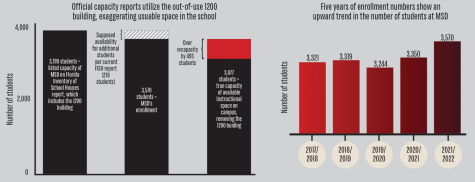
So why is the 1200 building still on MSD’s FISH report?
The Eagle Eye reached out to Violet Brown, the Senior Educational Program Director for the Florida Department of Education. Brown is listed as the contact on the FLDOE’s official FISH webpage. Brown referred us to Brett Tubbs, FLDOE Press Secretary, who never responded to our multiple attempts to get answers to our questions about why the 1200 building remains on MSD’s FISH report. He only provided an official copy of the report.
BCPS offered an explanation for the building’s continued inclusion on MSD’s FISH report.
“School capacity is a state-level calculation [that] is not determined in Broward County. This policy frequently results in redundant or unusable facility space being included in a school’s capacity and is such with the 1200 building at Marjory Stoneman Douglas High School,” Young said. “The 1200 building will remain in the school’s total capacity, however, until it is demolished.”
According to Young, the 1200 building cannot be removed due to Chapter 6, Section 6.1 (5) of the State Requirements for Educational Facilities. It is the district’s position that it can not legally remove the 1200 building from the MSD FISH report, until it is demolished.
However, SREF Section 6.1 (5) does not set specific conditions that must be met, like the demolition of the building, to remove it from the FISH report. It merely states “a district’s facilities inventory shall be corrected when new additions or remodeling occurs, during a validation study, or in any other event that causes or results in a change in square footage, student stations, design of a facilities space or the condition of a facilities space.”
In fact, BCPS reported a change in Plantation Middle School’s capacity to the state at the end of the 2020-2021 school year when it designated a building to be used by district security staff due to under-enrollment at the school. The conditions of the space changed, it was reported to the state, and that change is now reflected in Plantation Middle School’s FISH report.
In looking at BCPS’s Planning Tool for School Capacity, which under close examination does not accurately reflect MSD’s enrollment numbers or capacity percentages for last year or the current year, it is clear that BCPS does eventually intend to remove the 1200 building from MSD’s FISH report in two school years. The planning tool shows the capacity number dropping down from 3,789 to 3,077 in the 2023-2024 school year.
“The FISH Inventory represents the buildings as they were approved by the board and the FLDOE at the time of construction. The tragic circumstances that happened in the building do not change the original purpose of the construction,” Sandra Garzon, coordinator for the BCPS Facility Planning and Real Estate Department, said. “The School Board of Broward County is pending to receive clearance from authorities to demolish this building since it is part of an open investigation; that is why the data is not showing a potential demolition until Fiscal Year 2023-2024. If clearance occurs sooner building 12 will be removed from the inventory at that time.”
However, the district’s explanation ignores the portion of SREF 6.1 (5) that accounts for any event that changes the condition of a facilities space.
“I think that the district is required, under Section 6.1(5) to accurately record any decrease in student stations and update the information by submitting transactions through EFIS,” Joseph Garrity, an attorney at Lorium Law, said. “My opinion is that ‘or in any other event’ is purposefully broad to allow the district to account for many conditions that make student stations unusable.”
Garrity has two decades of litigation experience and one of his specialties is in construction defects. He is also a former industrial and construction engineer.
“For the purpose of comparing SREF definitions [page 23] states that relocatables that fail to meet standards…shall not be reported as providing satisfactory student stations in FISH. In other words, if you can’t use them don’t count them. Why would the 1200 building be different?” Garrity said. “[page 88] ‘Student Station’ is defined as ‘For planning purposes, the net square footage… per student… based upon the instructional program to be housed; used primarily to determine student capacity of school. No instructional program should ever be housed in the 1200 building and [page 87] further defines ‘Student Capacity’ as the number of students that can be satisfactorily housed in a facility at any given time.”
Garrity is also the director of Shine MSD, a not for profit foundation formed in the wake of the MSD shooting that seeks to heal the community through the arts. He is the parent of an Class of 2019 alumna and a current MSD student.
“Satisfactorily is defined by Oxford as ‘in a way that fulfills expectations or needs; acceptably,’’ Garrity said. “I have worked with hundreds of students, through Shine MSD since Feb. 14, 2018. They all deal with PTSD every day. There is nothing acceptable about ever using the 1200 building as satisfactory ‘Student Stations.’”
Additional Acres
As a public school, MSD is required to accept all students within their school attendance boundaries. Factors like construction in the north part of Parkland along Loxahatchee Road, in conjunction with an exploding real estate market, has caused enrollment to swell and it could continue to grow.
About 75 acres of residential area in other cities near east Parkland will likely be annexed into Parkland, according to Vice Mayor Bob Mayersohn.
A final meeting on Nov. 3 will decide whether this will occur. If adopted, all 55+ communities in the annexed area will be altered to be open for residents of all ages. Considering this area accounts for about 210 housing units, this could have a profound effect on the school enrollment numbers in Parkland in the future.
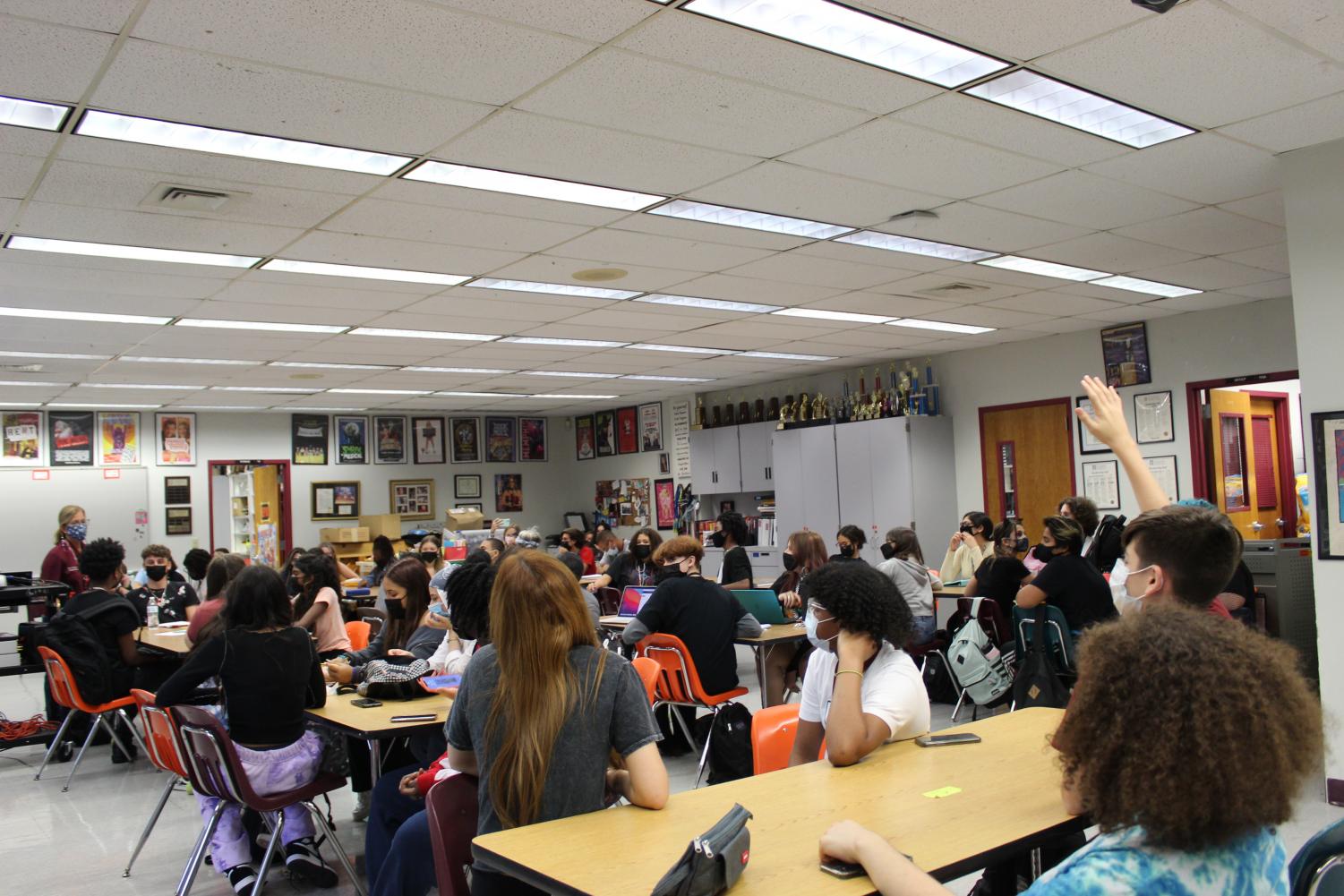
Populous Performers. Drama teacher Melody Herzfeld leads a class discussion about the play “Medea” with her 46 Theater I students in her 7th period. As an elective, the class enrollment is not limited to 25 students like core classes are under Florida’s 2002 Classroom Size Amendment.
Class Size Amendment
The consequences of growing enrollment and operating at 116% of MSD’s capacity translates directly to an increase in class size, which makes it difficult to comply with state requirements for class size.
In 2002, Florida voters approved the Class Size Amendment, which amended the state constitution and limited the number of high school students in core classes to 25. The Florida Legislature rewrote the statutes to allow the 25 class cap to apply to school-wide averages, instead of each individual classroom.
In addition, the Florida Legislature passed a new law in 2011, SB 2120, reducing the number of courses that would qualify as a “core” class from 849 to 304.
Florida State Statute 1003.1 defines core classes for the purposes of class size limits as “courses in grades 9 through 12 in subjects that are measured by state assessment at any grade level and courses that are specifically identified by name in statute as required for high school graduation and that are not measured by state assessment.”
It further defines extracurricular classes to include “all courses that are not defined as ‘core-curricula courses,’ which may include, but are not limited to, physical education, fine arts, performing fine arts, career education, and courses that may result in college credit.”
Following the passing of this law, classes ranging from marine science to trigonometry and all Advanced Placement courses are considered electives and are not capped.
This has been a frustration for teachers and students for years, even before MSD’s enrollment swelled to 3,570.
“I just don’t think a class like AP Government or AP U.S. History should fall under ‘elective choice’ because they’re both graduation requirement courses,” AP Government teacher Jeff Foster said. “I think it’s [kind of] silly that [the state government is] taking ‘lower-level courses’ and making them adhere to the 25 person rule, yet [they’re] taking classes that are probably more in-depth and more likely to have debate and discussion, and [they’re] throwing 35, 37, 38 kids in those classes; I think it’s a disservice to the kids in those classes.”
Most non-core classes at MSD are well over 25 students and some electives have climbed to over 40 students per period. The school administration has tried to alleviate the problem and bring down the numbers of students in each class by creating more classes or changing students’ schedules from larger periods to smaller ones. Assistant Principals Jay Milmed and Tariq Qaiyim continuously monitor the sizes of rooms across campus to ensure core classes stay at around 25 students.
“What [MSD administration has] done, this year especially, we’ve given a lot of extra periods to teachers to try to lower class size numbers,” Milmed said. “We are also hiring part-time teachers. Some of the things that we can do to mitigate overcrowding are adding classes so that we can bring down class size across periods and hiring another teacher or two, things of that nature.”
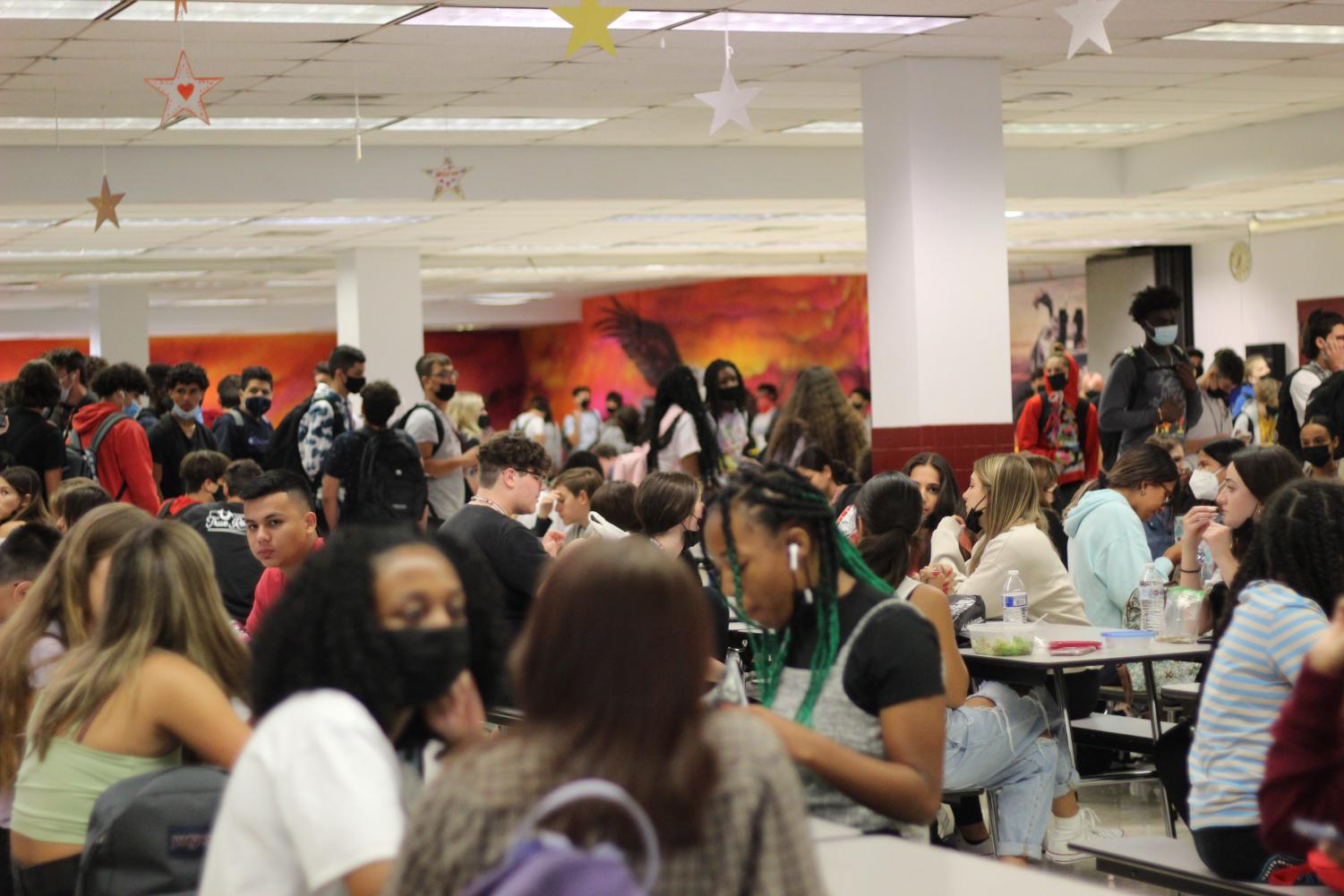
Lingering Lunch Lines. Students eat lunch in a packed cafeteria during B lunch on Aug. 20. Long lines at lunch have caused multiple announcements during the 1st quarter, excusing late students who are still waiting to get their lunch after class has started.
Bursting at the Seams
The increase in enrollment has set off a chain reaction of problems that have not existed in recent years.
With the ongoing COVID-19 pandemic, the overpopulation is making it more difficult for students to social distance. While all students and staff on campus must wear a mask at all times and social distance when possible, that is difficult to accomplish in packed hallways, classrooms, the lunchroom and other crowded spaces.
In the Classroom
Currently, all classrooms at MSD are being used, except for three rooms that are being fixed for roof leaks. A number of teachers have large classes that are struggling to fit within the physical space of their rooms, affecting students’ learning. Many teachers have classes of 30 to 40 students, which makes it hard for students and teachers to attain one-on-one attention when needed. One physical education period has 50 students.
“[The increase in students makes] it very hard to learn, especially in [AP] math when my class has 37 kids, it doesn’t make teaching personal and also [makes it feel] very rushed,” senior Asha Advani said.
According to Principal Michelle Kefford, some students were switched from large classes into different periods or assigned to new teachers with smaller classes. However, there is only so much the school can do with adjusting class sizes when there are no more rooms and the school tries to stay in compliance with the Florida Class Size Amendment Law in core classes. The direct consequence is an extreme increase in electives, which are not constrained by those rules.
Assistant Principal Daniel Lechtman explained that the school is currently being rebudgeted to potentially hire more teachers to alleviate the overcrowding. However, there are not any open rooms on campus to put new teachers in, which would make them floater teachers. A floater teacher would change class location throughout the day based on room availability per day or per period. Even if there were available classrooms to place newly hired teachers, schedule changes would cause major impacts on students who have already finished the first quarter of the school year.
The Between-Times
Students report struggling to travel throughout the campus. During passing periods, staircases are backed up with students. Crowds come to a standstill in the smaller hallways, making it hard for students to get to their classes on time.
“Certain intersections of school corridors become shoulder-to-shoulder traffic while everyone is transitioning to lunch, and it makes it too difficult to navigate safely with how close people are in a tight space like that,” senior Logan Walsh said.
Compounding the problem, passing time between classes went from 8 minutes to 7 minutes, giving students less time to get to class than in previous years when the campus was less crowded. Transitions to and from lunches are made more difficult with half of the student body trying to go to and from the courtyard with only 6 minutes to get back to class.
This is the result of an audit of the A/B block schedule completed by the FLDOE last school year, which revealed that students, specifically seniors, did not have enough instructional hours to graduate. In order to come into compliance, the A/B block schedule was altered district-wide. Time was removed from passing periods and 1 minute was added to each class period.
A Large Lunch
The increase in students has also led to many issues during lunch. Even MSD’s split lunches can’t solve the problem. The increase in enrollment equals approximately 110 more students per lunch. Students are not required to wear masks while eating in the cafeteria and social distancing is nonexistent.
“I don’t feel comfortable even taking my mask off at lunch because of how many people we have,” senior Julie Mouhica said.
Lunch lines are often so long that students have trouble fully eating their lunch before they have to go back to class. Multiple announcements throughout the first quarter have been made by Lechtman and Kefford at the end of both lunches asking teachers to excuse students coming in late from lunch to their next period, due to the long lunch lines in the cafeteria.
The main courtyard is a popular location for students eating lunch, but with the increase in the student body, the picnic tables and benches that line the courtyard are always full.
“It is always difficult to find seats at lunch, there is almost never a place,” sophomore Aneesha Nookala said. “I see many people sit on the stairs or even stand, just so they can eat.”
According to Kefford, the school has ordered 20 more picnic tables paid for by MSD’s Parent Teacher Student Organization at $875 per table, for the courtyard to provide more seating for the students outside and alleviate the crowd; it is unknown when they will arrive.
Getting Home
Additionally, students are having issues getting home from school in a timely fashion, including backup in the senior lot from the pickup line, underclassmen parked in North Community Park and a lack of buses.
“Traffic [is] bad to get home [after school, and it] took me 35 minutes when I live 5 minutes away,” senior Zachary Valdes said.
Additionally, there is a shortage of bus drivers across the district this year, resulting in many buses taking on multiple stop numbers. This essentially doubled the amount of kids on each bus where numbers had already been increasing.
End of day announcements by administration regarding bus changes occur frequently as the BCPS Student Transportation and Fleet Services Department tries to distribute bus sizes more evenly among all the available buses. Still with an increase in students on buses, students have to sit two and three to a seat, leaving no room to socially distance.
“[The] bus loop is overcrowded, and the bus [I] take is completely filled,” sophomore Arizel Corniel said.
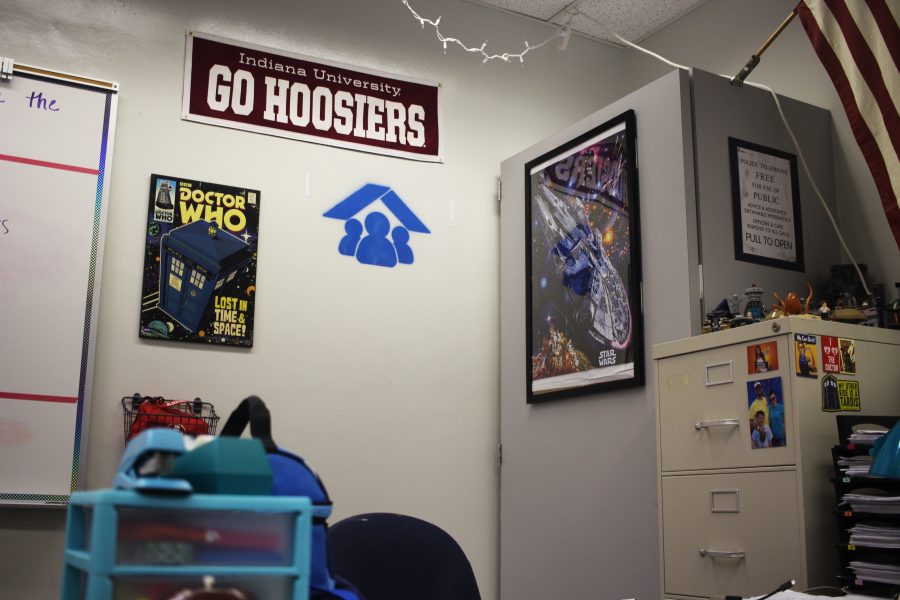
Nyan Clarke
Cornered. In 2019, symbols designating ‘hard corners’ or “safer spaces’ were spray painted in every classroom at Marjory Stoneman Douglas High School, except the portables, which are on lease. Symbols were changed from blue to red after stakeholder input. Increasing enrollment at MSD makes it more difficult for students to fit into “safer spaces” in the event of an emergency.
Safety Concerns
The increasing enrollment numbers and rising class sizes beg the question: how many students are too many for safety purposes?
Every room on campus, through the MSD FISH report, has a provided square footage. According to National Fire Prevention Association Standard 101, which is adopted into code by Florida Administrative Code 69A-58, to calculate the acceptable occupancy for each room of an educational facility, the room’s square footage is divided by 20 and then rounded up to the next whole number. That number is the max capacity of students that can be in that classroom for fire safety.
If you take the average size of the classrooms in MSD’s 200 building, 810 sq ft and divide it by 20, the number would be 40 students.
While it might be within fire safety limits of NFPA 101, contemplating the potential of 40 students in a classroom is overwhelming for many teachers, and is likely not the best learning environment for a student, even in an elective.
“I have 30 desks already in my classroom. I cannot fit 40 desks in my class,” interim English teacher Pamela Scopino, who teaches in the 200 building, said. “It would be tough, I would have to reconfigure everything and could not do that without blocking the exit and the conjoining door to the classroom next door.”
BCPS follows State Requirements for Educational Facilities adopted by Florida Administrative Code 6A-2.0010 which provides instruction considerations for determining classroom capacity.
“The criteria that affects the occupancy is the intended use of the room, recommended occupancy and net square footage of the room. Once the intended use of the space is determined, SREF provides a recommended occupancy and net square footage per occupancy required in each room,” Matthew Decker, Chief Fire Official for BCPS, said. “[For] example, according to SREF 2014, a general classroom senior high 9-12 recommends 25 occupants and 1 teacher and the recommended square footage is 32 per person which is 832 net square feet per room.”
According to Decker, a room is truly considered not safe when the ability for students to exit a room, called fire egress, is compromised and students cannot exit the building during an emergency. Even though classes are getting larger, the school is well within compliance with the NFPA 101 for fire safety and as well as SREF recommendations for educational planning and instruction.
While school district officials and the FLDOE consider fire safety and state classroom size amendment rules when calculating acceptable capacity numbers, there are other safety conditions not considered or addressed by Florida Administrative Code or SREF: active shooters.
Unfortunately, this is a situation the MSD community knows all too well. Even though fire code would allow 40 students in 812 square feet of classroom, that number would not fit inside the designated “safer spaces” in the classrooms at MSD. These are blind corners in each classroom, out of the line of sight from the windows on MSD’s classroom doors.
On Feb. 14, 2018, some students were killed and others injured when they could not fit into the “safer space” corners of the classrooms in the 1200 building.
Although MSD has not exceeded the capacity threshold that would cause a fire safety issue or an issue of compliance with state mandated class size for core classes, MSD’s enrollment is still above the number of students recommended for the actual accessible instructional spaces on campus.
As elective class numbers rise, an active shooter situation would put students in larger classes in danger if the designated “safer space” is not large enough to fit all the students.
Mapping the Difference. When a school is overcrowded, one possible solution includes redrawing boundary lines. This map shows the current boundary lines for all the high schools in the Coral Springs/Parkland area. The shaded lines are areas that could potentially be considered for rezoning. There are no plans at this time to redraw the boundaries lines for MSD, which is a year-long process.
What Now?
The MSD administration is working to mitigate the effects of the increasing enrollment this school year; however, it is important to note that the school administration can only provide short term solutions for this long term issue. Long term solutions must come from BCPS and take time.
When a school reaches 100% capacity level, as dictated by the available space on the school’s FISH report, BCPS Policy 5000 illustrates the solutions the district can follow. For MSD, this will not happen until one of two situations occur to reveal our current capacity at 116%.
Either BCPS removes the 1200 building from MSD’s FISH report or the MSD community waits until the enrollment reaches 3,789 students.
Rezoning the Region
Policy 5000 identifies, “[Re-]designating schools and school attendance zone boundaries for the ensuing school year(s),” as one possible solution to over enrollment.
With the current zoning and boundaries in place, the MSD zone extends north to Loxahatchee Road, also known as the Broward County border line with Palm Beach County, east to State Road 7 and south to Wiles Road. The southern boundary also includes a small section of area up to Royal Palm Boulevard between Coral Springs Drive and University Drive and west up to an uninhabited conservation area.
“These [rezoning] options may include changes to attendance areas/boundaries, but could also include a full-school address verification process to ensure students actually reside in the boundary,” Young said. “The designation of ‘overcrowded’ is based on the current year’s enrollment and the next year’s projected enrollment, rather than a past trend.”
With the area’s unusual shape, one possibility could include making Wiles Road the southern boundary. This would cut off Running Brook Hills, Broken Woods and several other neighborhoods located in Coral Springs, causing their assigned school to be Coral Glades High School rather than MSD.
Some of those neighborhoods already have the ability to choose to go to Coral Glades High School instead of MSD. In addition to changing the southern boundary, another possibility could be moving the eastern boundary westward, causing parts of East Parkland to be rezoned for Monarch High School.
“I think that [redrawing the boundary] is a great idea considering that in a few years, MSD’s population may only increase,” senior Jonathan Penn said. “This definitely should be done just for the overall safety of the students in today’s world and because there is not enough room to fit all these new students.”
However, the process to redraw the boundary of any section of the district takes a significant amount of time and often causes conflict within the community. The school boundary community review process typically takes 12 months, and kicks off with a school board workshop in May and completes with at least two public hearings in the following February-April to adopt the new attendance areas for all schools for the following school year.
“I feel like [redrawing the boundary] would be wrong in a sense. Many students have built special friendships and relationships at this school already. If a significant amount of students were interested in rezoning, then sure,” senior Noldine Belizaire said.
The rezoning of the MSD school district has the potential to impact many within the Coral Springs and Parkland communities, but it would bring down the enrollment numbers. It is also important to note that after zoning is changed, it would take about four years for the changes to make an impact on the capacity of MSD, since BCPS would not remove current students who attend MSD and are outside of the newly drawn boundary; it would only apply to the future classes of MSD.
Grappling with Tragedy
Outside altering MSD’s attendance boundaries, there are several other ways to add capacity to the school, two of which involve the future of the 1200 building.
The presumption of the MSD community is that the 1200 building will be demolished at the conclusion of the criminal trial surrounding the Feb. 14, 2018 shooting at MSD. The State Attorney’s Office indicated in court proceedings that the state intended to have the jury walk the crime scene as part of their case against the shooter. On Wednesday, October 20, the shooter entered a guilty plea in court, which could potentially hasten the demolition of the building.
The demolition does not solve the current over-enrollment issues at MSD.
Keeping the 1200 building and renovating it, would add much needed classroom space. This would keep the existing exterior walls intact while only clearing out and redoing the inside of the building. While this might seem a practical solution, the emotional impact of keeping a building associated with such trauma is probably an unlikely outcome, especially since the budget already exists for the building’s demolition.
Demolishing the building and replacing it with a new building in the same location or another location is also a potential solution, both of which would require a lengthy planning process and funding. For comparison, the cost of the newly constructed 1500 building was $18 million dollars. Locations for a new building are extremely limited. Potential locations could include somewhere within the senior parking lot, the field between the 900, 400, and 1500 buildings, and the area near Marjory’s Garden and the baseball field.
Those in the MSD community have strong feelings as to what they would want to happen in the space where the 1200 building currently stands.
“I think the building should be [torn] down completely. It’s very traumatizing for those that were present during the horrific event,” Belizaire said. “I think it should be remade into a memorial or at least a building honoring the lives of those that were lost.”
Additional solutions could include adding modular units or portables on campus. During the two-year process of planning and constructing the 1500 building, 32 modulars were temporarily placed on top of the school’s outdoor basketball courts and utilized as classroom space. The area was affectionately named Eagle Village. The return of Eagle Village could solve the overcrowding issues at MSD, but would require funding.
None of the possible solutions can provide an immediate resolution and none of them will even begin to be considered until the FISH report accurately represents the usable instructional space on campus.
Editor’s Notes: Since 2018, it has been the position of the Eagle Eye Editorial Board not to include the name or photo of the Feb. 14, 2018 shooter in any of our publication’s coverage, as it is a PTSD trigger for our readership and we believe in the No Notoriety organization’s call for responsible media coverage in the interest of public safety when acts of mass violence are committed. Joseph Garrity’s law firm, Lorium Law, completed an internal conflict of interest review before he provided his legal opinion to the Eagle Eye.
This story was originally published in the October 2021 Eagle Eye print edition.
